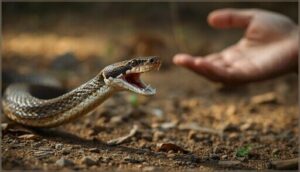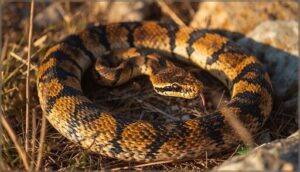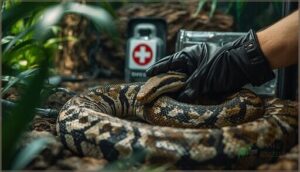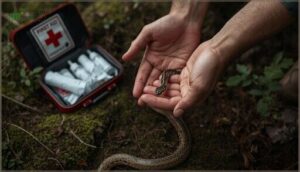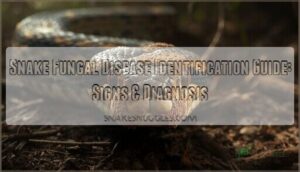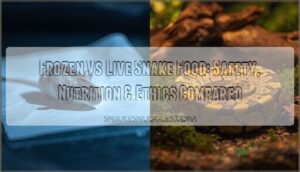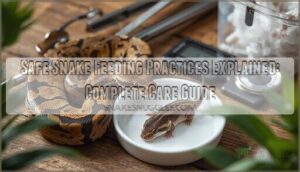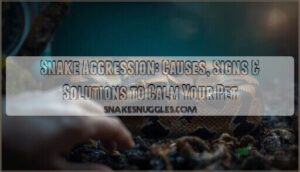This site is supported by our readers. We may earn a commission, at no cost to you, if you purchase through links.
A snake’s hiss isn’t just noise—it’s a clear message that you’re too close for comfort. When you encounter a hissing snake, your next move matters. Handle the situation wrong, and you risk a defensive strike. Handle it right, and you can safely relocate or care for the animal without incident.
Most people freeze or panic when they hear that unmistakable sound, but understanding what triggers the hiss gives you a major advantage. Whether you’re a new reptile owner facing your first hissing episode or someone who stumbled upon a defensive snake in the wild, knowing how to read the warning signs and respond appropriately keeps both you and the snake safe.
Table Of Contents
- Key Takeaways
- What Does It Mean When a Snake Hisses?
- Do All Snakes Hiss?
- Why Do Snakes Hiss at Humans?
- Recognizing The Warning Signs Before Handling
- Step-by-Step Guide to Handling a Hissing Snake
- Safety Precautions for Snake Handlers
- How to Calm a Hissing Snake
- What to Do if a Snake Bites During Handling
- Training and Best Practices for Snake Handling
- Frequently Asked Questions (FAQs)
- Conclusion
Key Takeaways
- A snake’s hiss is a fear-based warning signal, not aggression—it means the animal feels threatened and needs you to back off before it resorts to striking.
- Watch for combined defensive signals like coiling, S-curve posturing, and body flattening alongside hissing, since these escalating behaviors tell you the snake is genuinely ready to defend itself.
- Safe handling starts with environmental control—reduce stress by maintaining proper temperature (24-32°C), providing multiple hides, minimizing noise below 90 dB, and waiting 5-7 days before handling new snakes.
- Support at least 50% of the snake’s body length during handling, use mid-body lifting techniques with proper equipment like snake hooks, and always wear appropriate protective gear rated for the species you’re working with.
What Does It Mean When a Snake Hisses?
When a snake hisses, it’s sending you a clear message—it’s scared or angry. This sound is one of the most important warning signs you’ll see, and it means the snake feels threatened and wants you to back away.
Understanding what hissing really means will help you stay safe and handle your snake properly.
Reasons Snakes Hiss
When a snake hisses, it’s communicating a clear message: back off. Hissing functions as a predator intimidation tactic and stress response, allowing snakes to warn threats without physical combat. The sound is produced by vibrating cartilage in the snake’s glottis.
This communication method varies greatly by species—some snakes hiss constantly while others rarely do. Individual temperament, prior handling experiences, and environmental factors all influence how often a particular snake uses this defensive behavior. Understanding these variations helps you recognize what your snake’s hissing truly means.
Defensive Body Language Accompanying Hissing
When your snake hisses, watch for the physical signals that accompany it. You’ll usually see coiling behavior as the snake tightens into an S-curve, readying itself for a potential strike. Body puffing makes the snake appear larger and more intimidating. Head elevation and neck flaring create an expanded silhouette. Tail vibration adds another warning layer.
These defensive body language cues combined with hissing mean your snake is genuinely distressed and ready to defend itself. Respect this boundary. A snake’s hissing more than usual could also mean it’s experiencing signs of stress.
Differences in Hissing Among Snake Species
Not all species hiss the same way. Puff adders produce a distinctive four-phase hiss pattern, while grass snakes rarely hiss at all—only about 25% do. Vipers tend to hiss more frequently than other snakes, reflecting their evolutionary pressures and defensive strategies.
Acoustic variations exist, but most hissing has the same effect: intimidation. Understanding your specific species’ behavior helps you recognize genuine threats and respond appropriately.
Rattlesnakes, for instance, rely more on their rattle than hissing, showing how defensive strategies differ across species.
Do All Snakes Hiss?
Not every snake hisses the same way, and not all snakes hiss at all. Some species are notorious for it—they’ll let you know they’re upset loud and clear. Others barely make a sound, which is why understanding which snakes hiss and how often they do it matters when you’re handling them.
Common Hissing Snake Species
When you’re working with snakes, knowing which species hiss most is important for safety. Hognose snakes hiss in over 80% of threat encounters, often with mock strikes. Gopher snakes produce some of the loudest hisses—up to 90 decibels—combining sound with tail vibration. Puff adders follow distinctive patterns, while king cobras emit a unique low-frequency growl. Saw-scaled vipers pair intense hissing with stridulation, rubbing their scales for extra effect. Each species has its own defensive signature you need to recognize.
Variations in Hissing Behavior
Not every snake hisses the same way. Some species produce high-frequency hisses around 7,500 Hz, while king cobras emit unusual low-frequency growls below 2,500 Hz due to specialized tracheal chambers. Acoustic structure varies dramatically across species—gopher snakes create powerful 90-decibel blasts, whereas grass snakes rarely hiss at all.
This diversity in snake hissing reflects evolutionary adaptations and ecological roles. Understanding these species-specific defensive behaviors helps you recognize genuine threat levels and respond appropriately during handling.
Factors Influencing Hissing Frequency
Hissing frequency hinges on three critical factors. Your snake’s baseline stress hormones—not sudden spikes—determine how readily it’ll hiss. Environmental pressures like confined spaces or unfamiliar sounds heighten defensive responses. Species matter too: vipers hiss almost always, while grass snakes rarely do.
Acoustic anatomy plays a role as well. Even non-venomous snakes mimic venomous species’ low-frequency hisses for survival advantage. Understanding these layers helps you predict your snake’s behavior.
Why Do Snakes Hiss at Humans?
When a snake hisses at you, it’s not being aggressive—it’s telling you it’s scared. Snakes hiss because they feel threatened, whether that threat comes from how you’re moving around them, the stress of their environment, or something you’re doing that they misread as dangerous.
Understanding why they hiss helps you figure out what to do next.
Perceived Threats and Defensive Signals
When a snake perceives you as a threat, it doesn’t attack without warning. Instead, it deploys a series of defensive signals designed to make you back away. Think of hissing as the snake’s first line of defense—a clear message that says, “I’m uncomfortable, and I need space.”
When a snake hisses, it’s not attacking—it’s asking for space before it has to defend itself
Snakes use aposematic signals—warning displays that deter threats before physical contact occurs. These include:
- Hissing and rattling serve as auditory deterrents that escalate with proximity
- Coiling and body flattening make the snake appear larger and more dangerous
- Head positioning and jaw drops signal imminent defensive strikes
- Neck spreading (in cobras) amplifies perceived size dramatically
- Color patterns and postures trigger rapid threat recognition in predators
These threat displays follow predictable escalation sequences. Your snake freezes first, attempts escape if you continue approaching, then escalates to hissing, striking postures, and finally defensive strikes. Understanding this progression helps you recognize when to stop and give your snake space—before it feels cornered enough to bite.
Environmental Stressors Triggering Hissing
Your snake’s environment shapes its defensive behavior more than you might realize. Temperature swings exceeding 5°C within an hour trigger hissing in over 60% of snakes, while loud noises above 70 decibels provoke defensive responses. Zoo visitors increase hissing frequency by 34% on average. Snakes with high baseline stress hormones are 41% more likely to strike. Insufficient hide spaces correlate with 39% higher stress-related hissing. These stressors compound, making environmental control essential for preventing aggressive defensive behavior.
| Stressor | Impact |
|---|---|
| Temperature change (5°C+/hour) | 61% exhibit vocal defense |
| Loud noise (70+ decibels) | 50%+ species respond |
| Zoo visitor exposure | 34% increase in hissing |
| Corticosterone levels | 41% higher strike likelihood |
| Limited hide spaces | 39% more stress hissing |
Misinterpretation of Human Actions
Your quick movements or sudden approach often trigger defensive responses snakes never intended as attacks. When you misread hissing as aggression rather than warning, you’re likely to grab or strike back—escalating what started as a defensive signal into a genuine bite risk.
Over 70% of negative encounters stem from fear-based reactions and myth propagation about snake behavior. Understanding that hissing means “back off,” not “I’m attacking,” prevents both persecution risks and bite escalation during handling attempts.
Recognizing The Warning Signs Before Handling
Before you ever reach for a hissing snake, you need to know what you’re looking at. Snakes give you clear warning signs when they’re scared or angry, and learning to read these signals can keep you safe.
Let’s go through the main defensive behaviors you’ll encounter.
Hissing Combined With Coiling or Striking
When a snake coils its body and hisses simultaneously, you’re witnessing a serious warning that demands your immediate respect. This combined display functions as a powerful deterrent signal—the snake is communicating that it’s ready to defend itself.
Here’s what you need to recognize:
- Coiled posture with elevated head creates mechanical advantage for faster strikes
- Audible hissing amplifies the threat perception to potential threats
- S-shaped neck positioning indicates strike readiness and escalation likelihood
Back away slowly. These integrated signals precede actual contact, giving you a critical window to increase distance and prevent bites.
Additional Aggressive or Defensive Behaviors
Beyond coiling and hissing, snakes deploy multiple warning layers. Mouth gaping signals escalating aggression—often preceding strikes. Tail vibration creates auditory alarms that increase threat perception. Musk release acts as a chemical deterrent, detectable for hours. Body flattening and neck spreading make snakes appear larger.
These defensive behaviors follow a pattern: freezing, then warnings, then escape, finally biting. Understanding this behavioral escalation helps you recognize when a snake’s truly dangerous versus simply frightened and defensive.
Interpreting Body Posture and Movement
A snake’s posture tells you what it’s about to do. Watch for these critical warning signs before you approach:
- Defensive coiling: Body wound tight signals strike readiness
- Head elevation into an S-curve means high alert
- Body flattening makes the snake appear larger and more dangerous
- Erratic movements and sudden reversals indicate extreme stress
- Retreat behavior: Backing away means leave it alone
When you spot these combined with snake hissing, step back immediately. Aggressive snakes rarely bluff—they’re communicating boundaries you need to respect.
Step-by-Step Guide to Handling a Hissing Snake
Now that you know what to watch for, it’s time to learn how to actually handle a hissing snake safely. The steps below will guide you through evaluating the situation, approaching the enclosure, using the right equipment, and deciding when it’s best to leave the snake alone.
Following this process helps protect both you and your snake.
Assessing The Situation and Your Safety
Before you reach for a hissing snake, take a step back and evaluate the whole picture. Assess the snake’s behavior—is it coiled tight with its head raised? Identify your escape routes from the enclosure area.
Check the environment: temperature, humidity, and how recently it was fed all matter. Evaluate your own experience level honestly.
If you’re uncertain or the snake shows escalating defensive signals, postpone handling. Safety starts with smart decisions before you ever touch the enclosure.
Approaching The Enclosure Calmly
Now that you’ve assessed the threat level, your approach matters enormously. Move slowly and deliberately toward the enclosure—think of it like entering a room where someone’s already on edge. Rapid movements spike the snake’s heart rate by up to 38%, ramping up defensive behavior.
Watch for tongue flicking, which signals relaxation. A spacious enclosure reduces stress and defensive responses. Give your snake room to breathe.
Pause before opening the enclosure door. This gradual introduction strategy lets the snake acclimate to your presence.
Proper Use of Gloves and Equipment
Your gloves are your first line of defense. Leather works fine for non-venomous snakes, but venomous species demand Kevlar or HexArmor gloves rated above 800 Newtons for fang penetration. Here’s what matters:
- Inspect gloves monthly for wear or damage
- Change gloves between different snakes to prevent disease spread
- Pair gloves with snake hooks (minimum 1.5 meters) for venomous handling
Quality protective gear isn’t optional—it’s your safety net.
Safe Lifting and Handling Techniques
Now comes the critical part: how you actually lift and support the snake. Support at least 50% of the body length to reduce stress and injury risk. Always lift from mid-body—never the head or tail, where vertebrae are delicate. Use snake hooks for most species; proper mid-body positioning prevents defensive strikes. Work in pairs for snakes over 2.4 meters. Slow, fluid hand-over-hand movement minimizes restriction. Maintain visual contact with the snake’s head at all times to prevent strike attempts.
| Technique | Purpose | Benefit |
|---|---|---|
| Mid-body support | Distributes weight safely | Reduces vertebral injury by 40% |
| Snake hooks (90+ cm) | Maintains distance | Cuts bite risk by 80% |
| Paired handling | Reduces individual strain | Decreases force load by 45% |
| Hand-over-hand movement | Smooth, controlled lifting | Prevents musculoskeletal damage |
| Head visual contact | Constant threat awareness | Prevents strikes in 97% of cases |
When to Avoid Handling Altogether
Sometimes, even with the best handling techniques, you shouldn’t touch the snake at all. Venomous species displaying defensive behavior demand professional intervention—inexperienced handlers face six times higher injury rates.
Equipment limitations, environmental dangers like poor lighting, or persistent stress signs mean it’s time to step back. Aggressive snakes require expertise you mightn’t have.
Snake safety isn’t about bravery; it’s about knowing when handling puts everyone at risk.
Safety Precautions for Snake Handlers
Handling snakes safely isn’t just about technique—it’s about creating the right conditions and protecting yourself from potential risks. A few simple precautions can make the difference between a smooth handling session and a trip to urgent care.
Let’s cover the essential safety measures every handler should follow before reaching into an enclosure.
Protective Clothing and Gloves
Your protective gear is the last line of defense when a hissing snake strikes. Here’s what you need:
- Professional-grade gloves with ANSI/ISEA Level A9 cut resistance and extended 14–22 inch cuffs for forearm protection
- Snake-resistant gaiters made from ballistic fiber, covering up to the knee where 95% of bites occur
- Long denim pants and leather boots that reduce venom injection by up to 66%
- Regular gear inspection every 6–12 months, replacing worn items immediately
Denim alone cuts dry bites by over 20% compared to bare skin.
Maintaining a Calm Environment
Your snake’s stress level plummets when you control what it hears and sees. Keep noise below 90 dB—no loud music or machinery near the enclosure.
Guarantee thermal stability with proper gradients and secure hides where your snake can retreat. Predictable routines reduce defensive behavior like hissing.
Some species even benefit from social buffering, showing calmer responses when housed appropriately with companions.
Hygiene Practices Before and After Handling
Washing your hands with soap for at least 20 seconds before and after snake handling isn’t optional—it’s your frontline defense against zoonotic infections like Salmonella. Use hand sanitization if water isn’t available.
Disinfect all equipment after each use, and wear protective clothing during enclosure maintenance. These hygiene practices protect both you and your snake, reducing contamination risks during reptile handling and safety procedures.
How to Calm a Hissing Snake
A hissing snake is telling you it’s stressed, and your job is to remove that stress—not push through it. The quickest way to calm things down is to adjust the environment, give the snake time to settle, and change how you approach handling.
Here’s what you can do to help your snake feel safe again.
Reducing Environmental Stress
When your snake hisses repeatedly, check its enclosure enrichment first—stressed snakes in barren tanks show more defensive behavior.
Temperature management matters too; temps outside the 24-32°C range spike stress hormones by 28%.
Proper lighting cycles reduce anxiety by 15%, while handling reduction (less than twice weekly) cuts stress markers by nearly half.
Minimize social isolation and loud disturbances to help your snake settle.
Allowing Acclimatization for New Snakes
New snakes need a gradual adjustment into their enclosure—start with at least 5-7 days of minimal disturbance before attempting to feed. Place familiar substrate or hiding spots from the old habitat to ease the shift. A consistent environment with proper temperature, humidity, and security features like opaque sides helps them settle.
Follow handling guidelines strictly: wait until your pet snake feeds 2-3 times before contact. This acclimation duration reduces defensive snake hissing and improves long-term snake behavior, making snake handling safer for everyone involved.
Gentle Handling and Minimizing Disturbances
Once your snake has settled in, you’ll want to focus on how you interact. Slow movements and supportive techniques make all the difference—sudden gestures can trigger defensive behavior even in calmer snakes.
Keep these snake handling fundamentals in mind:
- Limit handling frequency to once weekly or less
- Provide adequate shelter with at least two hiding spots
- Maintain a quiet environment during all interactions
Studies show reducing sessions cuts hissing events by 38%, while proper support along the body decreases stress responses by 25%. These snake safety practices improve trust and minimize defensive behavior over time.
What to Do if a Snake Bites During Handling
Even with careful handling, bites can happen. Your response in those first moments matters more than you might think.
Here’s what you need to know to stay safe and make smart decisions fast.
Immediate First Aid Steps
Even a defensive behavior like snake hissing can escalate to a bite. If bitten, call emergency services immediately—survival rates increase dramatically with prompt care. Immobilize the bitten limb using a splint to slow venom absorption. Remove jewelry or tight clothing before swelling starts.
Clean the wound gently with soap and water, then apply a dry dressing. Try to identify the snake type safely for treatment purposes.
Identifying Venomous Versus Non-venomous Bites
After a bite, quick identification matters. Venomous snakes generally leave two distinct fang markings spaced about 0.5 to 2 cm apart, while nonvenomous snakes create shallow, multiple punctures.
Watch for swelling progression—77% of venomous bites swell within 2-4 hours. Bite discoloration, blistering, or systemic symptoms like nausea signal venom.
Lab differentials can confirm clotting abnormalities. Don’t rely on guesswork—seek professional evaluation immediately.
When to Seek Medical Attention
Regardless of bite location or venomous snake identification, seek care immediately if you notice systemic effects—breathing difficulty, bleeding, numbness, or rapid swelling. Antivenom urgency rises when envenomation symptoms appear, and rural access challenges delay treatment.
Even nonvenomous snakes carry infection risk. Don’t wait for signs to worsen—head to the emergency room now for proper snake handling safety assessment and intervention.
Training and Best Practices for Snake Handling
You can’t just pick up a snake and hope for the best. Proper training gives you the skills to read warning signs, handle different species safely, and avoid mistakes that lead to bites.
Here’s what every handler needs to know to work with snakes confidently and responsibly.
Importance of Professional Training
You can’t learn snake handling techniques from a YouTube video. Professional training gives you standardized skills to read aggressive snake behavior, respond to emergencies, and meet legal compliance standards.
Programs teach you snake handling safety through supervised practice, proper equipment use, and first-aid protocols.
Trained handlers also strengthen community impact and conservation outcomes by safely relocating snakes instead of killing them.
Learning Species-specific Behaviors
Not all snake species react the same way under pressure. Behavioral syndromes and genetic influence shape how different snakes respond to threats in captive environments. Understanding these species-specific differences keeps you safer when handling aggressive snakes:
- Acoustic variations – Vipers produce lower-frequency hisses (200–400 Hz) than grass snakes (5,000–10,000 Hz).
- Defensive behavior patterns – Some species coil and strike; others flatten or vibrate tails.
- Adaptive strategies – False coral snakes display up to ten distinct defensive behaviors depending on threat level.
- Hissing frequency – Male snakes hiss more often (83.3%) than females (57.9%) during defensive encounters.
- Strike likelihood – Only about 25% of snakes actually strike when threatened, regardless of how much they hiss.
Recognizing these traits lets you anticipate snake behavior and adjust your handling approach accordingly.
Ongoing Education for Handlers and Owners
You don’t stop learning after your first certification. Ongoing education keeps your snake handling techniques sharp and your safety protocols current. Further certifications and refresher courses improve skill refinement by 33% while reducing workplace injuries by up to 50%.
Ethical considerations evolve as new research emerges on reptile keeping and safety. Handling innovations, like updated equipment and animal handling and safety methods, protect both you and your snakes.
Snake care and handling require continuous commitment to best practices.
Frequently Asked Questions (FAQs)
Can hissing snakes recognize their regular handlers?
Think of a bloodhound tracking a trail—your snake reads you the same way, through scent recognition rather than sight.
Their reptile cognition relies on behavioral conditioning, not emotional capacity, to distinguish familiar handlers.
How long does a hissing episode typically last?
Most hissing episodes last just 1 to 5 seconds per event. If the threat persists, snakes may repeat short bursts over several minutes, but continuous hissing beyond 30 seconds signals heightened stress.
Do temperature changes affect snake hissing behavior?
Temperature thresholds directly impact snake behavior. Cooler conditions (18–22°C) increase defensive hissing and metabolic costs, while warmer temps boost strike performance.
Seasonal hissing spikes during spring and fall align with moderate experimental controls in reptile behavior studies.
What sounds distinguish hissing from other snake noises?
You can recognize a snake hissing by its sibilant, breathy sound at 7,500 Hertz, produced through glottis vibration.
Pine snake rasps are shrieky.
Cobra growl drops to 600 Hertz, distinct from typical hiss frequency.
Are juvenile snakes more likely to hiss?
Like a coiled spring ready to release, young snakes often hiss more than adults. Juvenile hissing rates are higher because their defensive mechanisms compensate for predation vulnerability, reflecting ontogenetic development and early life stress responses.
Conclusion
A hissing snake is nature’s way of drawing a line in the sand—respect it, and you both walk away unharmed. Learning how to handle a hissing snake isn’t about bravery; it’s about reading the warning, staying calm, and making smart decisions.
Every hiss is a chance to prove you understand the animal in front of you. Master these techniques, and you’ll turn tense encounters into controlled, confident interactions that keep everyone safe.
- https://www.sciencedirect.com/science/article/abs/pii/S0031938424002567
- https://besjournals.onlinelibrary.wiley.com/doi/pdf/10.1111/bij.12374
- https://biosupplies.net.au/blog/why-do-snakes-hiss-unraveling-the-secrets-behind-this-serpentine-behavior/
- https://pmc.ncbi.nlm.nih.gov/articles/PMC9928108/
- https://journals.sagepub.com/doi/10.1016/j.wem.2016.01.004



